Oscars are among the most beautiful and popular cichlids in the aquarium industry. They are not overly aggressive, preferring to stay to themselves. They do well in aquariums with other fish of similar sizes and temperaments.
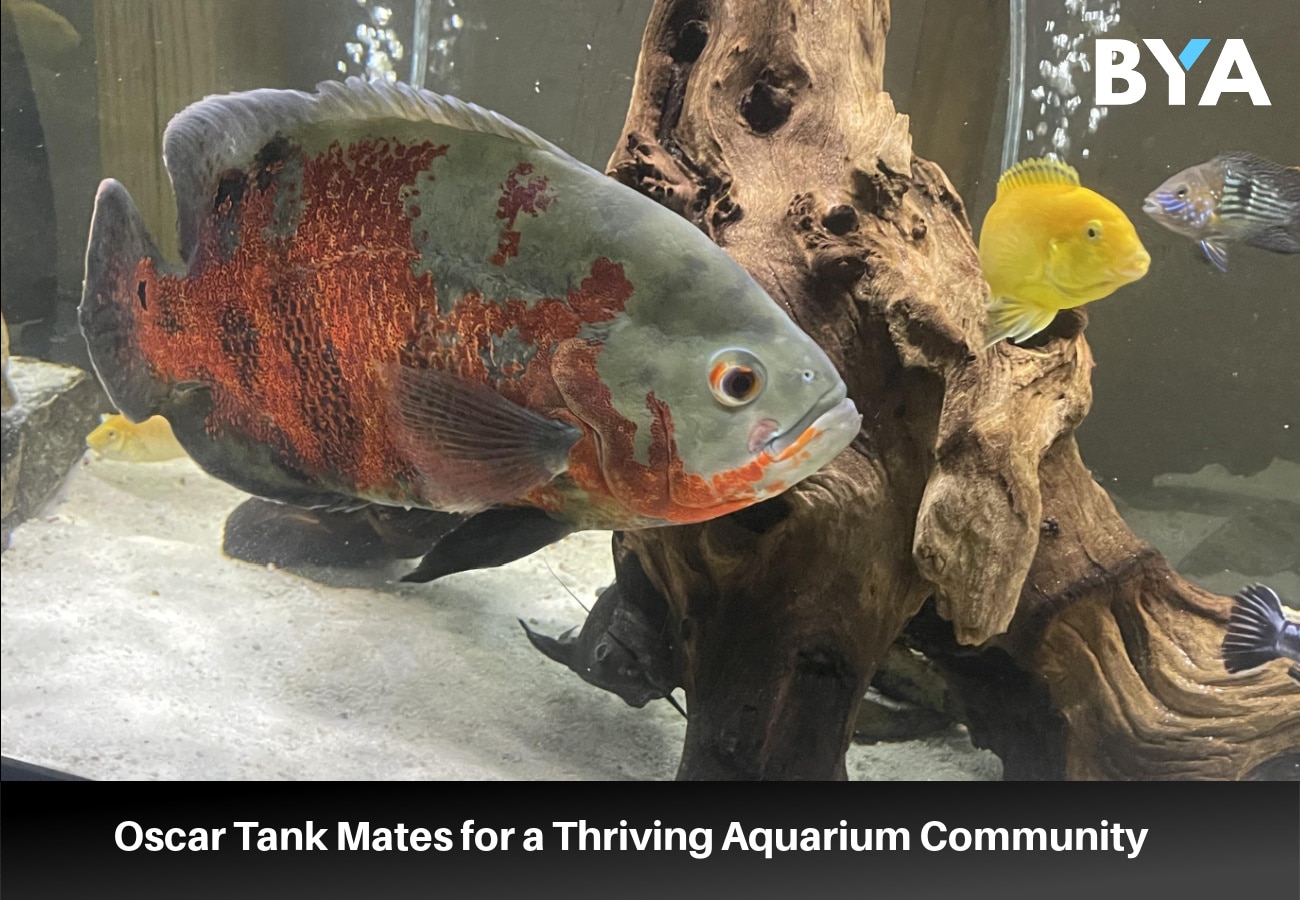
Oscar Tank Mates for a Thriving Aquarium Community
Consider any of the 19 fish below when choosing a tank mate for Oscars.
1. Another Oscar (Astronotus ocellatus)
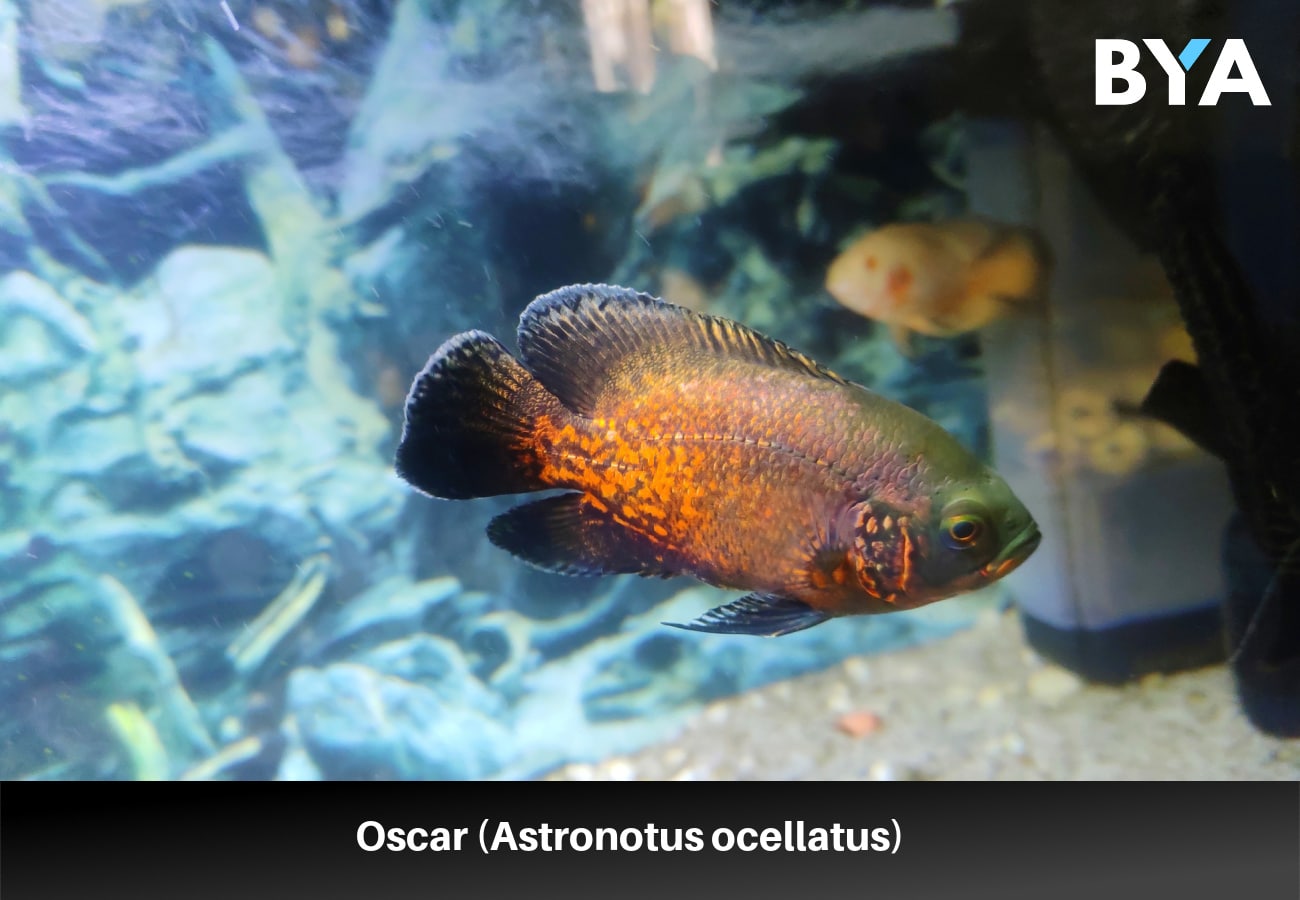
The best option is to keep two Oscars together since they have the same needs.
Keep in mind that Oscars produce a lot of waste and easily dirty up the tank. Two Oscars will need more space than one — at least 75 gallons.
A breeding pair of Oscars is the safest bet. Non-breeding pairs are likely to show aggression and injure one another. The smaller Oscar is likely to experience bullying and possible injury.
2. Bala Shark (Balantiocheilus melanopterus)
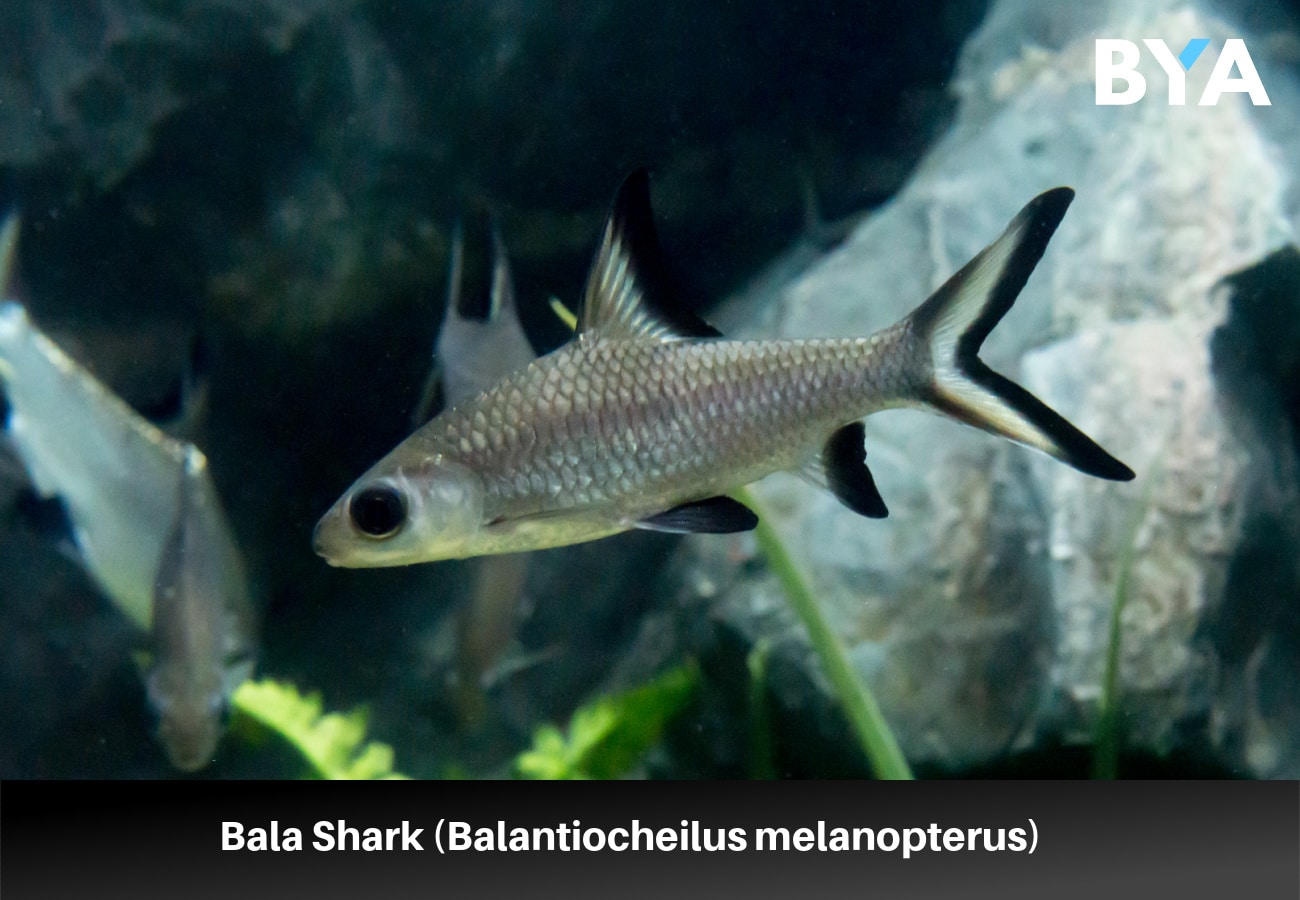
- Compatibility Rank: 10/10
- Care Level: Moderate
- Size: 12-15 in (30.5-38.1 cm)
- Aquarium Size: 180+ gallons
- Temperature Requirements: 73-82°F (22.8-27.8°C)
- pH Requirements: 6.0-7.5
- Swimming Level: Middle
- Temperament: Peaceful
Bala sharks aren’t really sharks. They get the name because their long, streamlined bodies resemble the fierce predators.
These “sharks” make excellent tank mates for Oscars. They are timid and won’t cause problems with their tank mates.
Bala sharks are schooling fish that can grow over a foot long, meaning they need lots of space.
The tricky thing about bala sharks is that they are large, strong, and skittish. They jump when nervous and are strong enough to knock lids off tanks.
Keep the lids secure to the tank. Avoid sharp decorations that may cause injury when the fish get fearful.
3. Bichir (Polypteridae family)
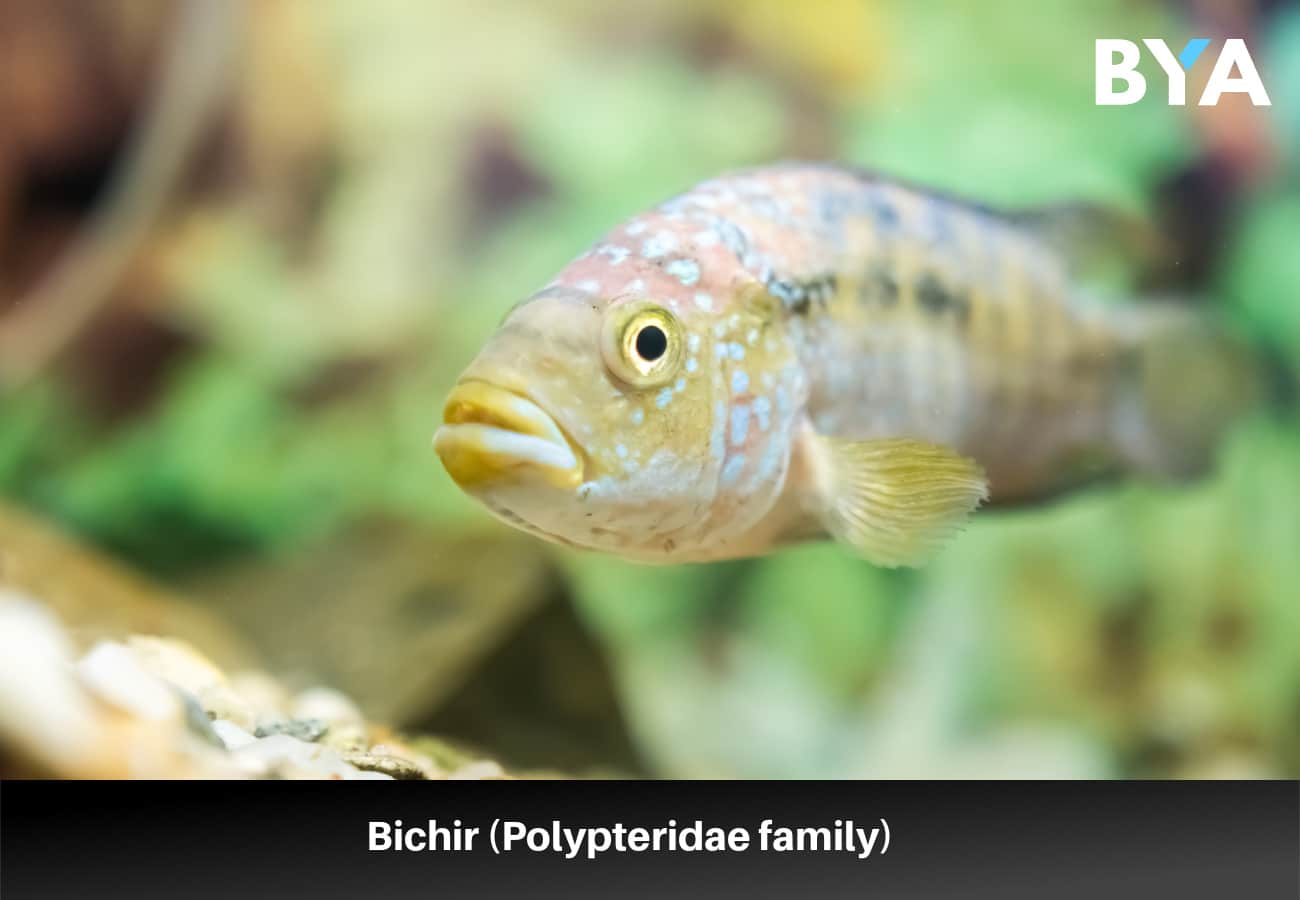
- Compatibility Rank: 10/10
- Care Level: Moderate
- Size: 1-3 ft (0.1-0.3 m)
- Aquarium Size: 55-250 gallons (varies by species)
- Temperature Requirements: 78-82°F (25.6-27.8°C)
- pH Requirements: 6.5-7.5
- Swimming Level: Bottom
- Temperament: Peaceful; Predatory
Bichirs are one of the most unique animals aquarists can have in their tanks. They are living fossils that are more than 400 million years old. They can grow a few feet long and can live for 10 to 15 years.
Bichirs spend most of their time at the bottom of the aquarium. They use their large pectoral fins to “walk” across the substrate.
These “dinosaur” fish have something in common with bettas: they breathe air.
Bichirs have gills to absorb oxygen from the water. They use their true lungs to breathe air when the oxygen levels drop too low. The oxygen levels in their natural habitats often drop dangerously low during drought.
Bichirs are predatory fish who hunt other fish. They are NOT aggressive and won’t attack anything that can’t fit in their mouths.An Oscar larger than a bichir’s mouth will be safe. Avoid keeping smaller, younger Oscars with large bichirs.
4. Blood Parrot Fish (Amphilophus citrinellus × Vieja melanurus)
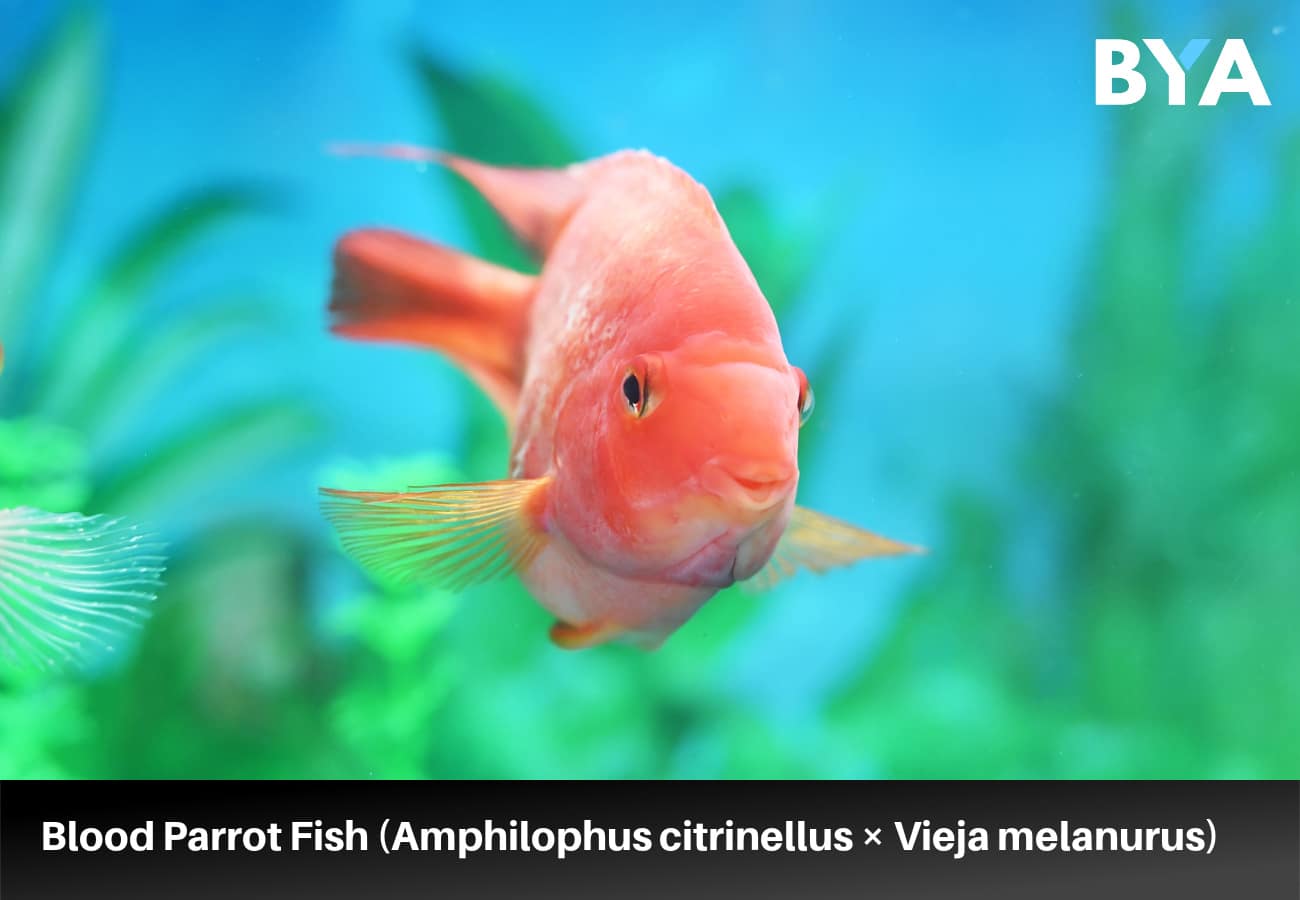
- Compatibility Rank: 9/10
- Care Level: Easy
- Size: Up to 8 in (20 cm)
- Aquarium Size: 30+ gallons
- Temperature Requirements: 72-82°F (22.2-27.8°C)
- pH Requirements: 6.5-8.0
- Swimming Level: Middle
- Temperament: Semi-Aggressive
Blood parrot fish are stunning, vivid fish with tiny mouths unable to hurt other fish. They have bold personalities and often try to boss other fish around.
Oscars have nothing to fear from blood parrot fish since their mouths are small.
Dither fish, larger tanks, caves, and tall plants help reduce aggression in parrot fish.
Blood parrot cichlids come in many colors, including orange-red. Other colors include sunshine yellow, red and white, and even purple.
They get the name “parrot” fish from their large, downward-pointing face. The shape of the face resembles a parrot’s beak.
5. Electric Blue Acara (Adinoacara pulcher)
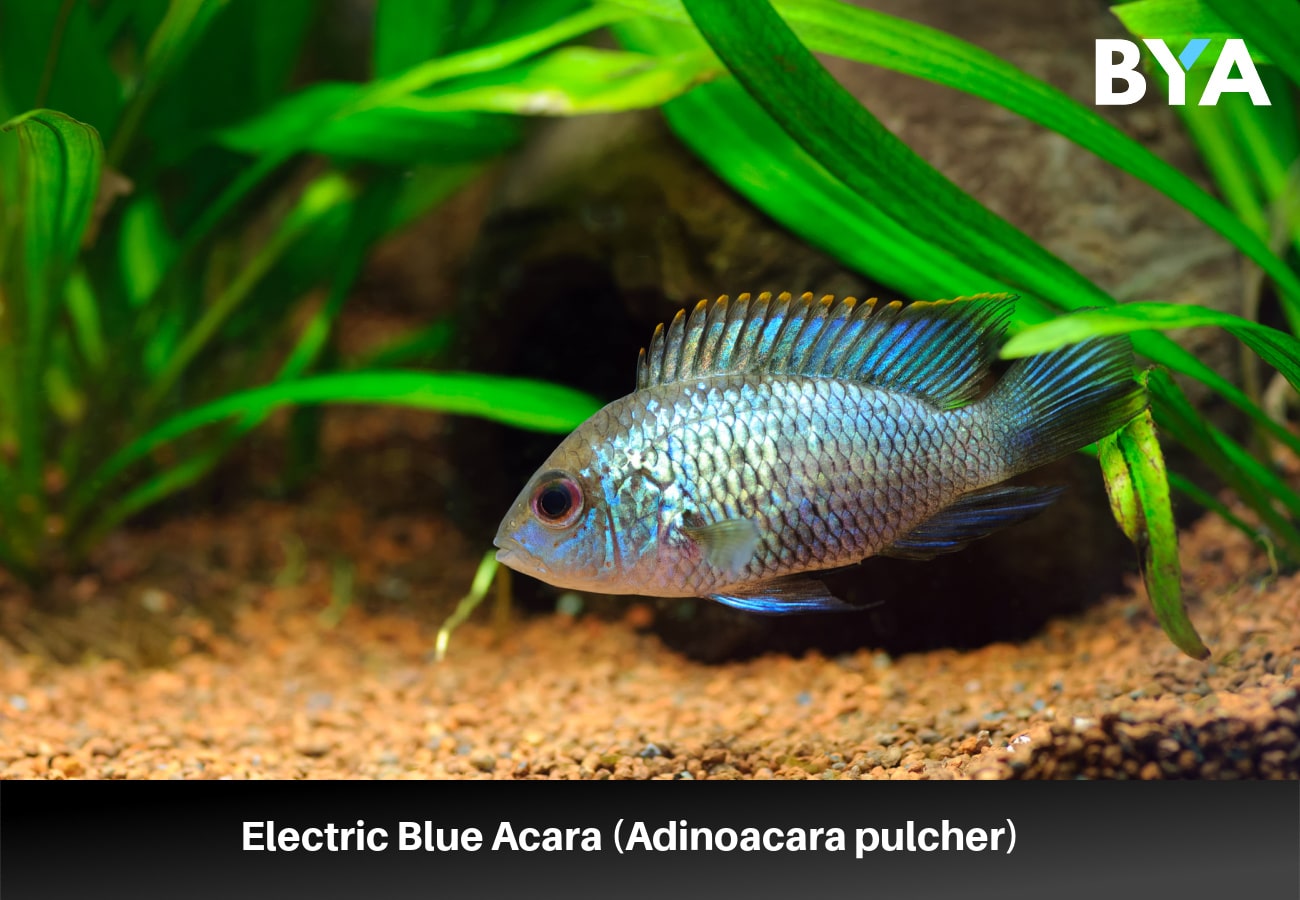
- Compatibility Rank: 10/10
- Care Level: Easy
- Size: 5-6 in (12.7-15.2 cm)
- Aquarium Size: 30+ gallons
- Temperature Requirements: 78-84°F (25.6-28.9°C)
- pH Requirements: 6.0-7.0
- Swimming Level: Bottom to Middle
- Temperament: Peaceful to Semi-Aggressive
Blue acaras are one of the more peaceful cichlid species, making them ideal tank mates for Oscars. They only tend to show aggression when it’s time to breed.
Adult electric blue acaras are large enough to handle bullying from the Oscars.
Besides their peaceful nature, their popularity stems from their appearance. Their scales and fins are combinations of iridescent blues and greens.
These fish are one of the most hardy fish on this list. The dirtiness of the Oscars doesn’t bother them.
6. Clown Loaches (Chromobotia macracanthus)
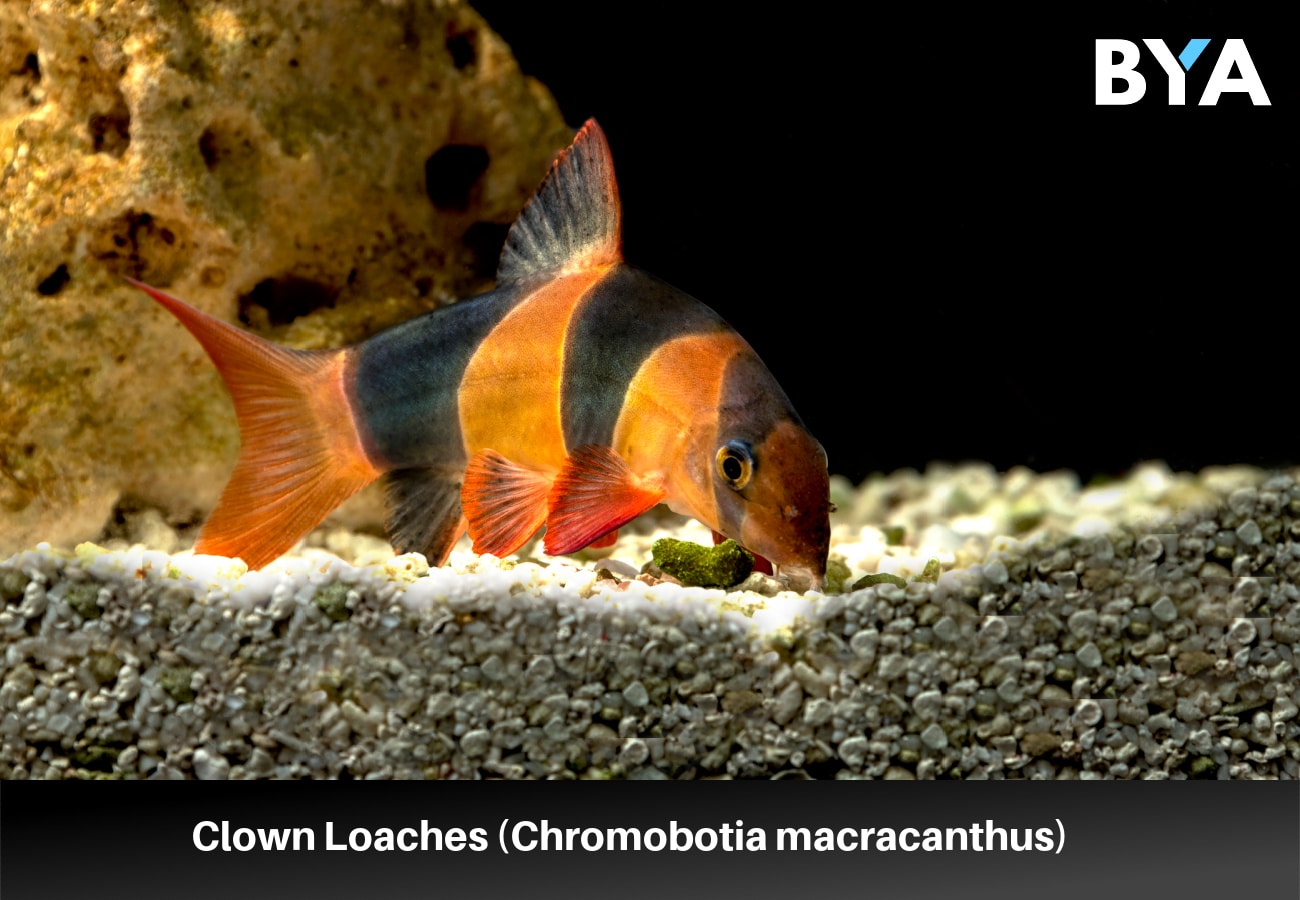
- Compatibility Rank: 10/10
- Care Level: Easy
- Size: 8-12 in (20.3-30.5 cm)
- Aquarium Size: 75+ gallons
- Temperature Requirements: 75-84°F (23.9-28.9°C)
- pH Requirements: 5.0-8.0
- Swimming Level: Bottom
- Temperament: Peaceful; Schooling
Clown loaches are ideal tank mates for Oscars because of their size and temperaments.
They grow to about the same size as Oscars, meaning they can take any nippiness the Oscars might display. Clown loaches are bottom dwellers and rarely interact with Oscars. Nipping is rarely a concern.
These loaches are peaceful and sociable animals. They enjoy being in groups of their species.
Clown loaches are fun because of their curious personalities. They often lay on their sides, flit about the tank, and swim upside down. They even make small clicking sounds with the teeth in their throats to talk to one another.
7. Convict Cichlid (Amatitlania nigrofasciata)
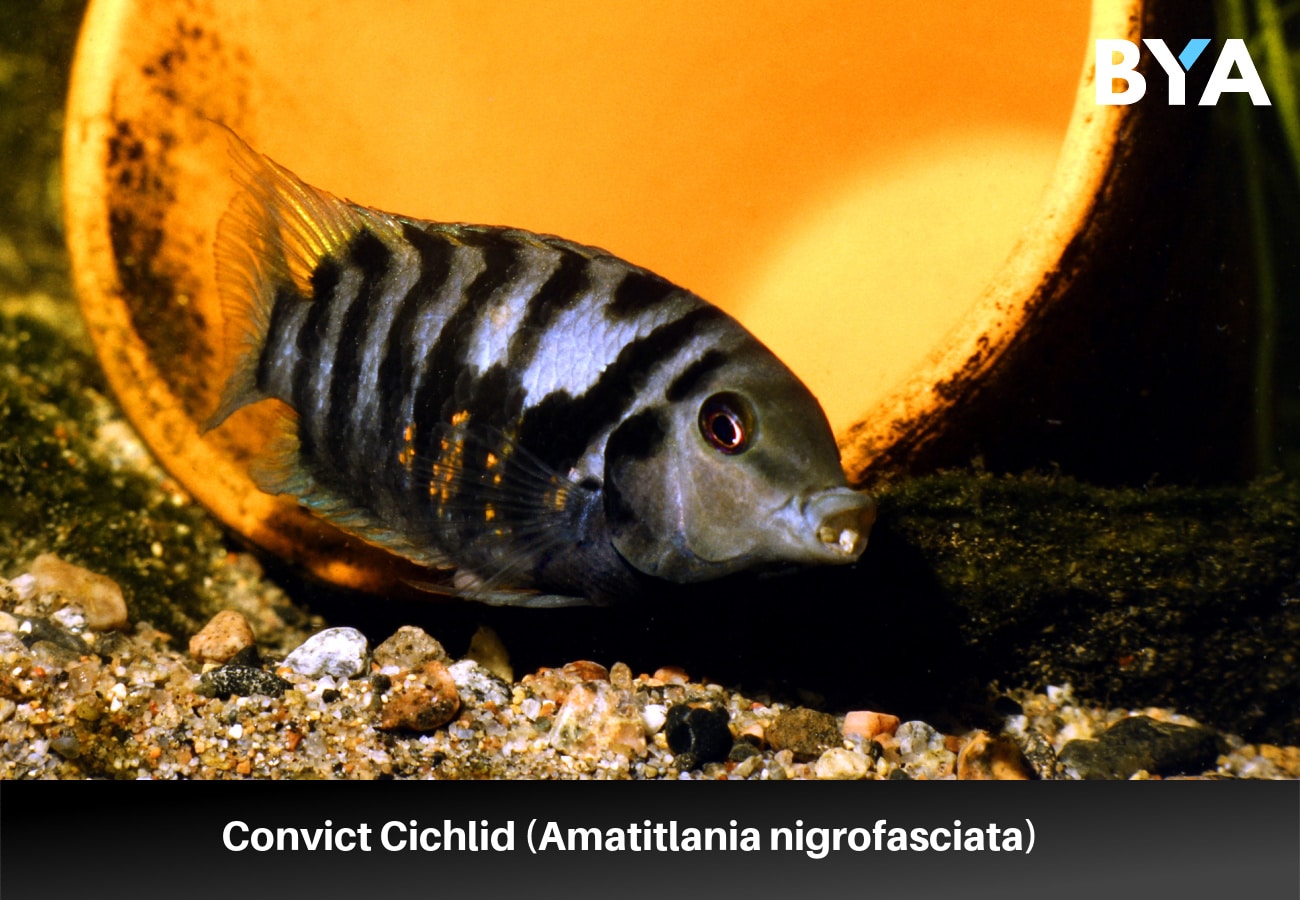
- Compatibility Rank: 8/10
- Care Level: Easy
- Size: Up to 6 in (15.2 cm)
- Aquarium Size: 25+ gallons
- Temperature Requirements: 70-82°F (21.1-27.8°C)
- pH Requirements: 6.0-8.0
- Swimming Level: All levels
- Temperament: Peaceful to Semi-Aggressive
Convict cichlids get their name for their black and white striping. The markings resemble what we sometimes see in prison uniforms.
Despite being smaller than Oscars, convict cichlids work well with small Oscars. They are aggressive enough to stand up for themselves if the Oscars decide to bully them.
It’s not a good idea to keep convict cichlids with full-grown, 15 in (38.1 cm) Oscars, as the Oscars will injure them. Try to match the two fish up in size, and be ready to separate the species once the Oscar(s) get too big.
Convict cichlids are hardy; they can handle a wide range of temperatures and pH levels.
8. Fire Eel (Mastacembelus erythrotaenia)
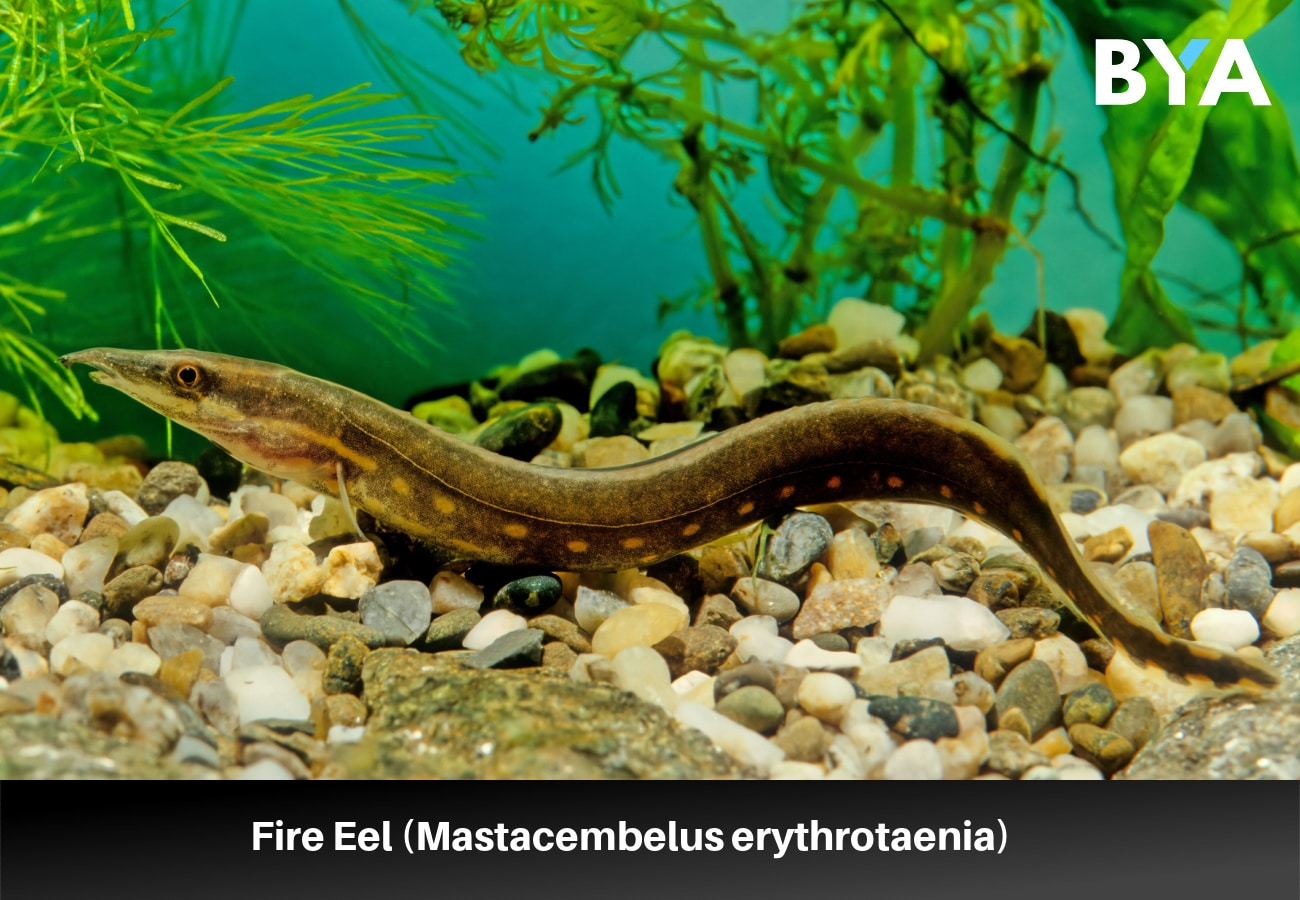
- Compatibility Rank: 10/10
- Care Level: Easy
- Size: 24-40 in (60-100 cm)
- Aquarium Size: 80+ gallons
- Temperature Requirements: 74-82°F (23.3-27.8°C)
- pH Requirements: 6.8-7.5
- Swimming Level: Bottom
- Temperament: Peaceful; Predatory
Fire eels have long, slim black bodies with bright red markings that give them their name. Despite having the name fire “eel,” these fish are not true eels.
These fish are predatory and will eat anything that fits in their mouth. Fortunately, that doesn’t include Oscars.
Fire eels have long and pointed but small mouths. At the end of their noses are two tube-like nostrils that they use for sensing prey.
Fire eels are peaceful to species that they can’t eat and spend most of their time at the bottom of the tank. They are highly aggressive toward other fire eels; only keep one per tank.
9. Firemouth Cichlids (Thorichthys meeki)
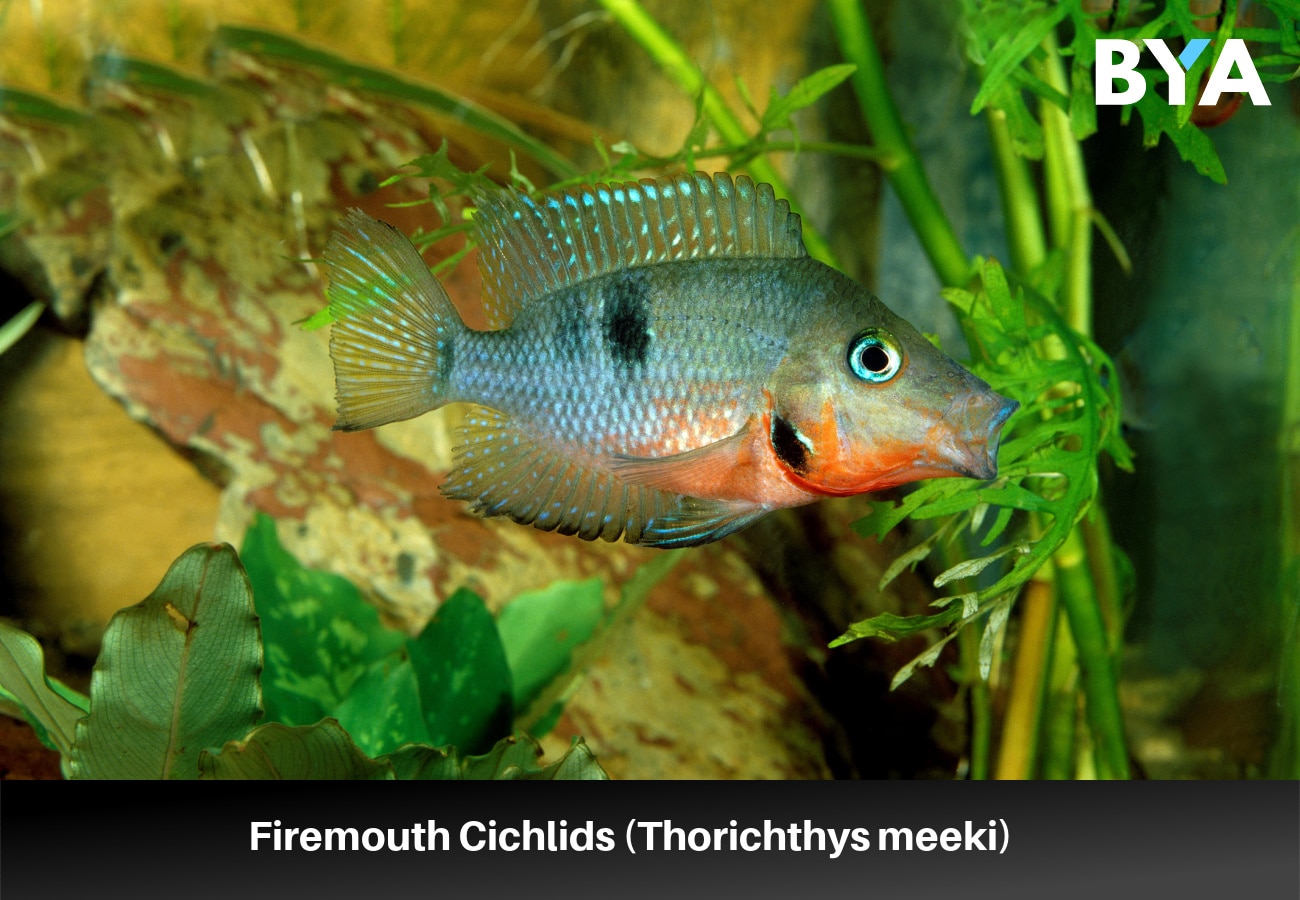
- Compatibility Rank: 10/10
- Care Level: Moderate
- Size: Up to 6 in (15.2 cm)
- Aquarium Size: 30+ gallons
- Temperature Requirements: 75-86°F (23.9-30°C)
- pH Requirements: 6.5-8.0
- Swimming Level: Middle
- Temperament: Semi-aggressive
Firemouth cichlids do well with Oscars because they aren’t usually aggressive. They can become somewhat territorial during breeding. They are primarily docile the rest of the time.
Firemouth cichlids are large enough to defend themselves against Oscars if necessary. Usually, they prefer to swim away rather than fight back.
Provide firemouth cichlids with lots of rocks and caves to hide in to help them feel secure.
The most popular feature of the firemouth cichlid is its vibrant red coloration. The red is present under the mouth and belly.
The rest of the body is slightly duller. They also have iridescent streaks throughout their fins.
10. Giant Gourami (Osphronemus goramy)
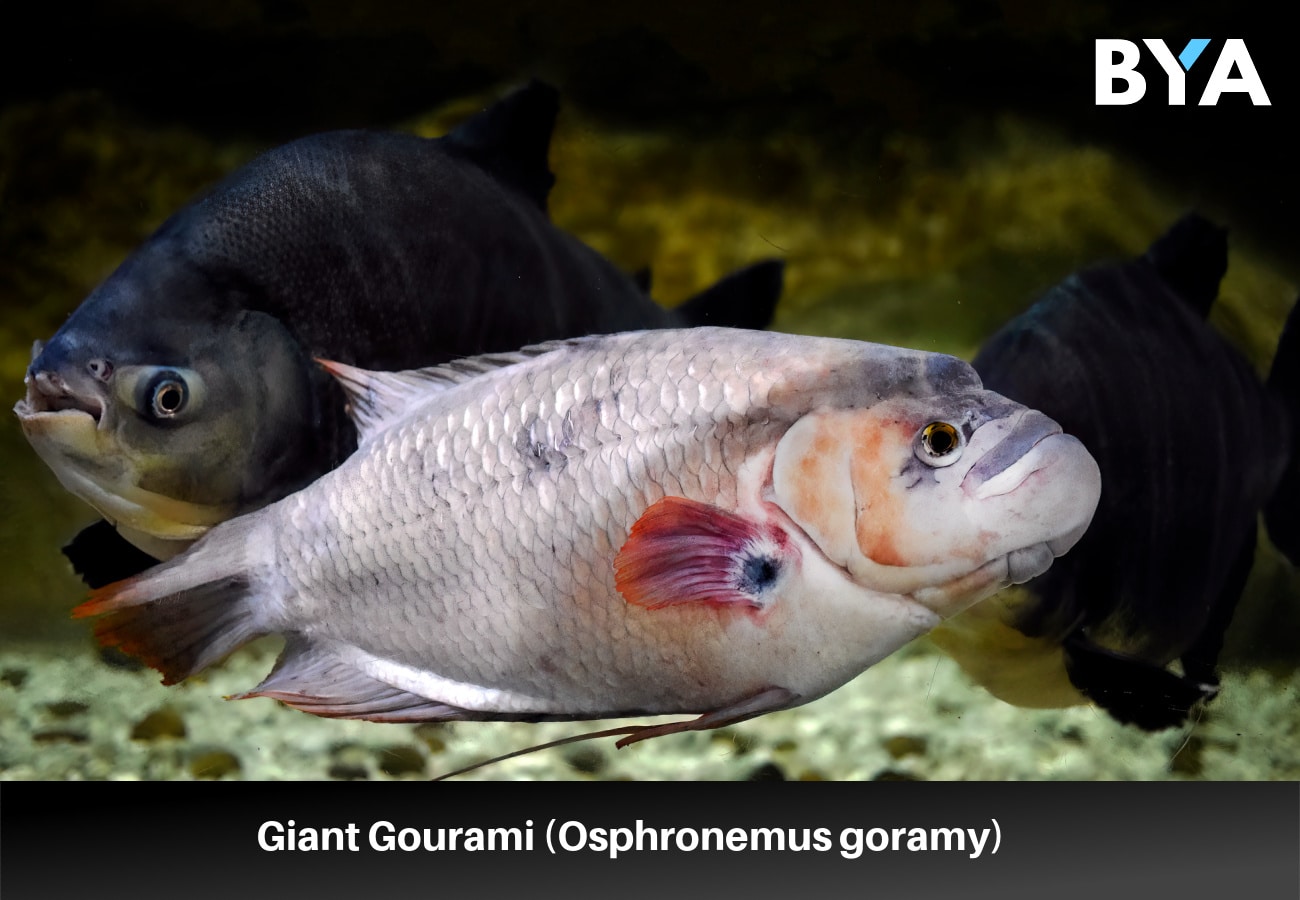
- Compatibility Rank: 10/10
- Care Level: Easy to Moderate
- Size: 16-18 in (40.6-45.7°C)
- Aquarium Size: 200+ gallons
- Temperature Requirements: 68-86°F (20-30°C)
- pH Requirements: 6.5-8.0
- Swimming Level: Top
- Temperament: Peaceful
Giant gouramis are ideal Oscar tank mates because of their docile personalities. They are solitary animals that do okay without other members of their species. Giant gouramis are so docile that some owners report being able to pet their fish.
These gouramis have long, pointed snouts and flat heads. Their bodies are usually darker in color with lighter patterning. Their foreheads swell as they age, and their lips get thicker.
11. Green Terror Cichlid (Andinoacara rivulatus)
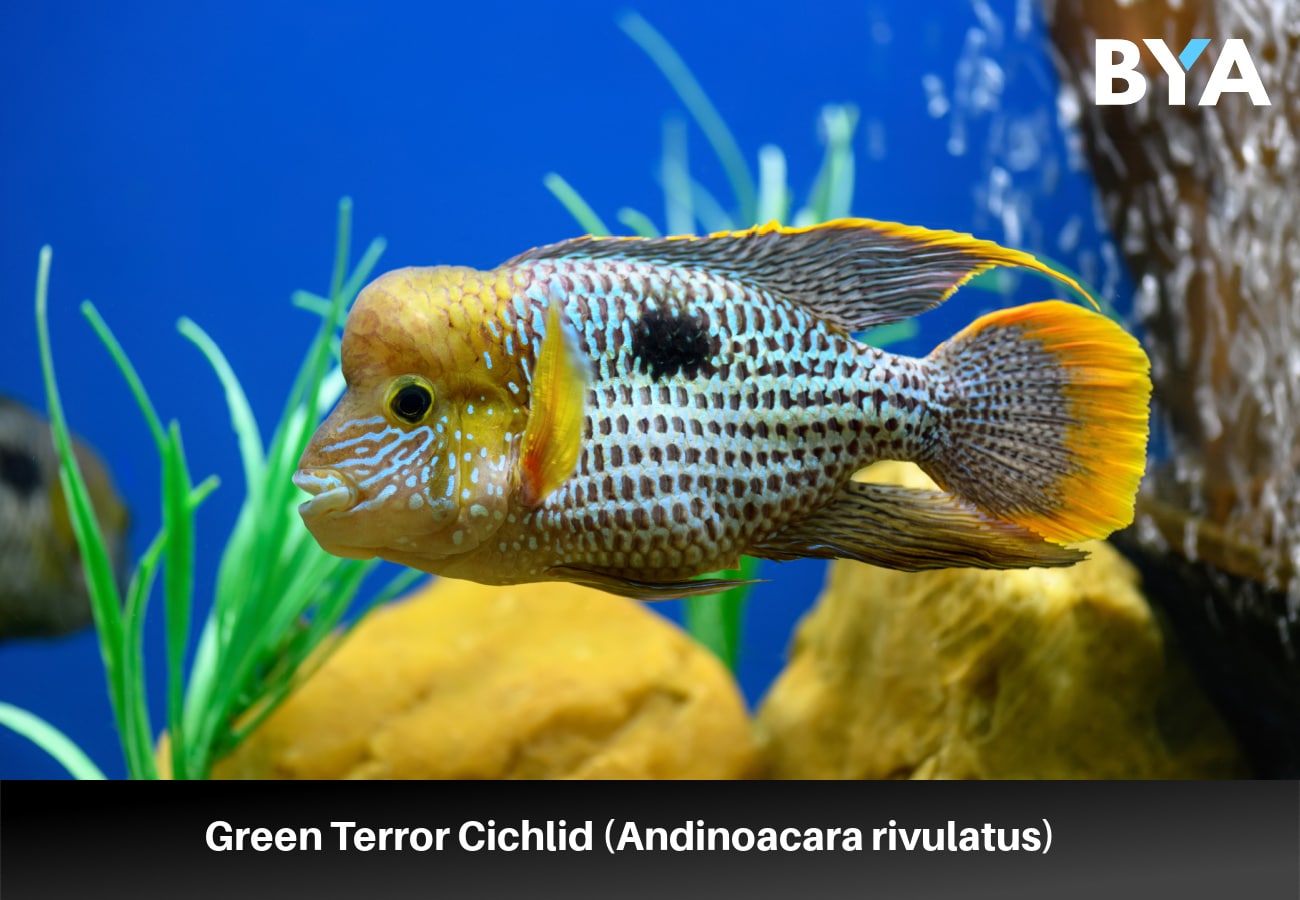
- Compatibility Rank: 8/10
- Care Level: Moderate
- Size: Up to 12 in (30.5 cm)
- Aquarium Size: 50+ gallons
- Temperature Requirements: 68-80°F (20-26.7°C)
- pH Requirements: 6.5-8.0
- Swimming Level: All levels
- Temperament: Aggressive
Green terror cichlids get their name from their aggressive personalities. Oscars can usually handle their hostility as long as the green terror(s) is small enough.
Ensure the green terror(s) is large enough that the Oscar can’t eat it, though small enough that it can’t cause harm.
As the green terror grows, it will become less aggressive toward the Oscar. Introducing green terrors to Oscars when they are young is key to curbing aggression.
Green terrors are striking fish with dark base colors and bright, iridescent scales. Their dorsal and tail fins have fringes of bright orange.
They are also active and curious, making them fun to watch swimming around the tank.
12. Jack Dempsey Cichlid (Rocio octofasciata)
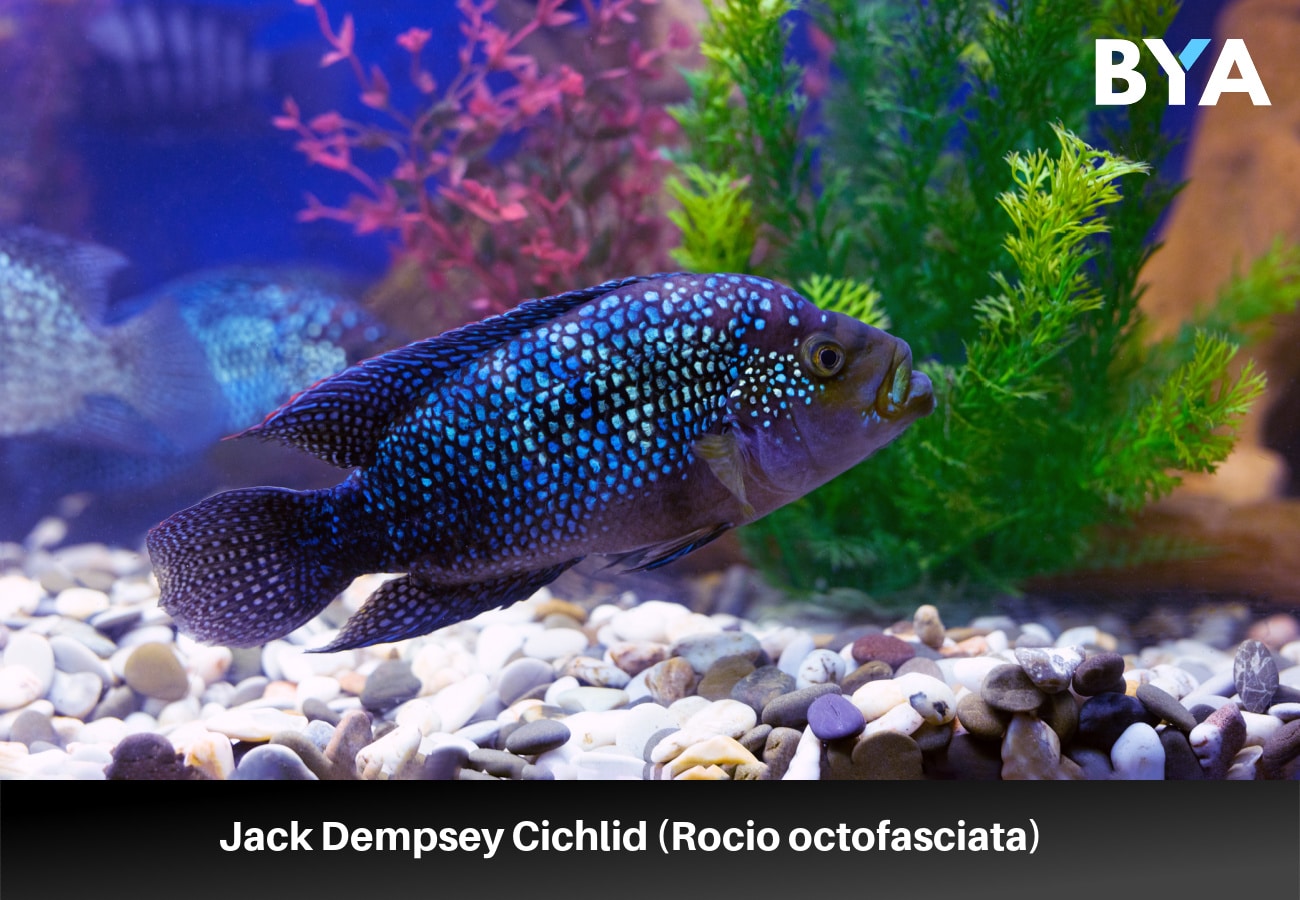
- Compatibility Rank: 9/10
- Care Level: Easy
- Size: 8-10 in (20.3-25.4 cm)
- Aquarium Size: 55+ gallons
- Temperature Requirements: 73-78°F (22.8°C)
- pH Requirements: 6.0-8.0
- Swimming Level: Middle to Top
- Temperament: Semi-Aggressive
These cichlids get their name from the boxer Jack Dempsey. Dempsey was a fierce fighter famous for his aggression in the ring.
Pet stores began selling Jack Dempseys in the early 1900s. At the time, they were one of the most aggressive species available.
There are many more cichlid species available today. Jack Dempseys are pretty tame compared to other species and don’t live up to their names.
Jack Dempsey cichlids can have a mean streak. They usually do well with other fish of similar personalities and sizes. They are quite close in size to Oscars and will usually leave them alone.
These fish are famous for their striking colors. Their scales are often a combination of dark and iridescent blues.
13. Jaguar Cichlid (Parachromis managuensis)
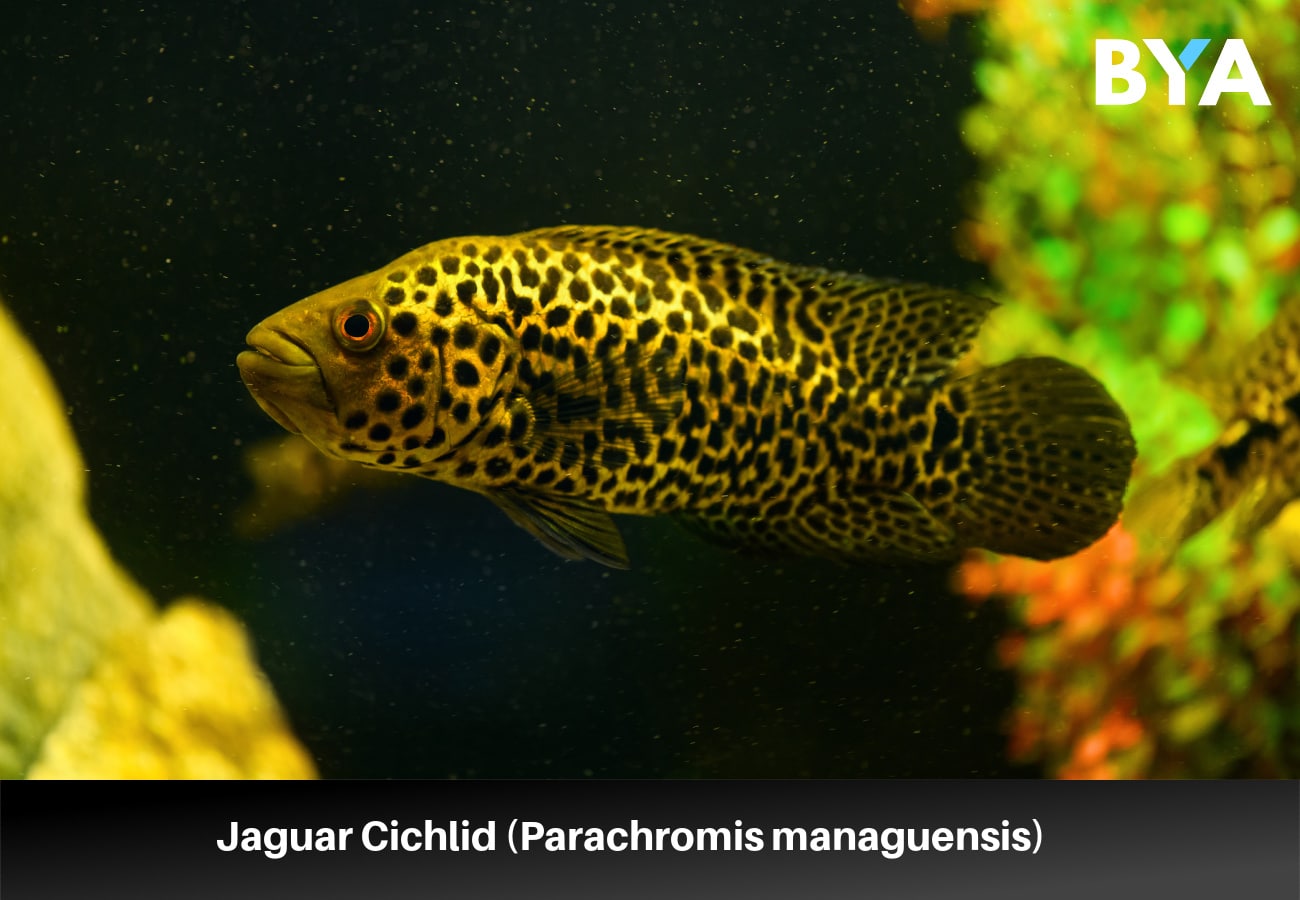
- Compatibility Rank: 7/10
- Care Level: Moderate
- Size: 14-16 in (35.6-40.6 cm)
- Aquarium Size: 100+ gallons
- Temperature Requirements: 73-82°F (22.8-27.8°C)
- pH Requirements: 7.0-8.7
- Swimming Level: Bottom to Middle
- Temperament: Highly Aggressive
Aquarists highly prize Jaguar cichlids for their colors and patterns. Their light, shimmering bodies have dark brown to black splotches. The splotches resemble those on jaguars.
These cichlids also get the “jaguar” name from their aggressive personalities.
Jaguar cichlids are fierce hunters that have sharp teeth and massive jaws. They are territorial and tend to pick fights with other fish.
Oscars usually do okay with jaguar cichlids since they are large enough to hold their own. Ensure the tank is more than large enough for the species to share space.
14. Jewel Cichlid (Hemichromis bimaculatus)
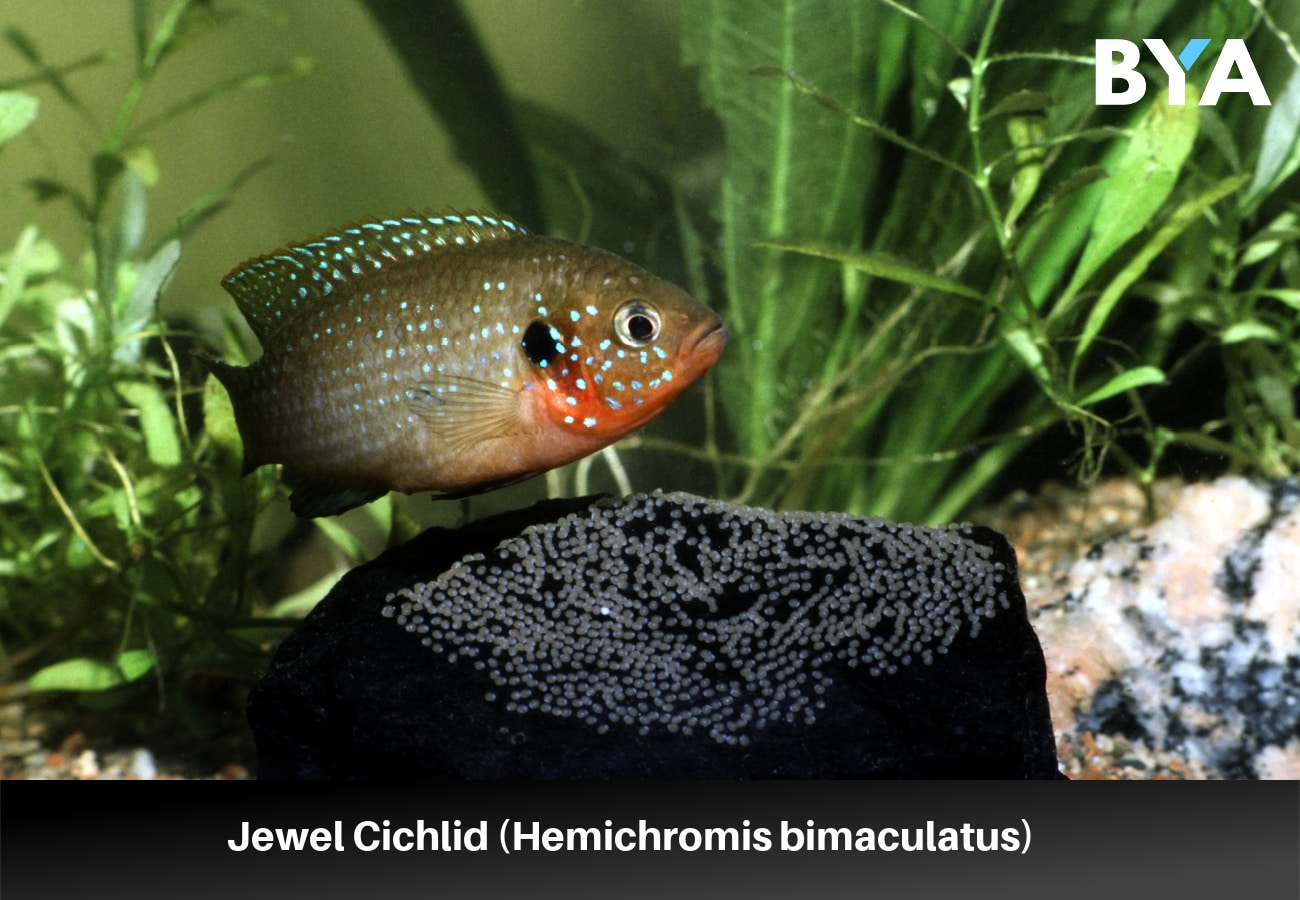
- Compatibility Rank: 8/10
- Care Level: Moderate
- Size: Up to 6 in (15.2 cm)
- Aquarium Size: 40 gallons
- Temperature Requirements: 74-80°F (23.3-26.7°C)
- pH Requirements: 6.5-7.5
- Swimming Level: Bottom to Middle
- Temperament: Semi-Aggressive to Aggressive
Jewel cichlids are one of the most striking fish that aquarists can keep. Many have vivid yellow, orange, and red bodies. Others have combinations of greens and blues.
The problem with jewel cichlids is their aggressive personalities.
Reduce their aggression by keeping them well-fed and giving them a space of their own.
Ensure they have plenty of room to move around, as they are highly active.
Their feistiness makes up for their smaller bodies.
Oscars aren’t too bothered by jewel cichlids since they’re larger. Jewel cichlids aren’t too bothered by Oscars because they can stand up for themselves.
15. Common Plecostomus (Hypostomus plecostomus)
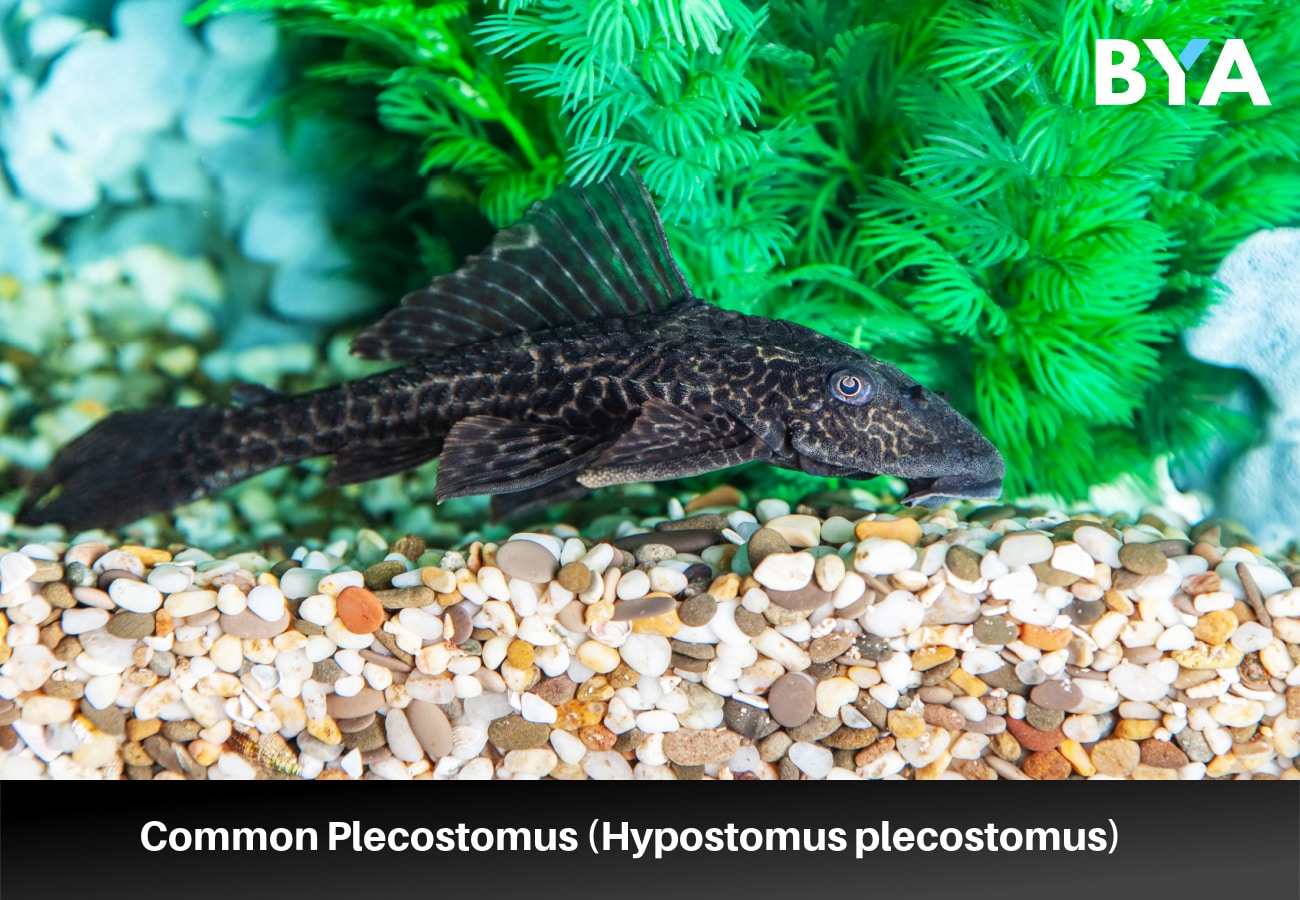
- Compatibility Rank: 8/10
- Care Level: Moderate
- Size: 12-15 in (30.5-38.1 cm)
- Aquarium Size: 55+ gallons
- Temperature Requirements: 75-85°F (23.9-29.4°C)
- pH Requirements: 6.5-8.0
- Swimming Level: Bottom
- Temperament: Peaceful (younger) — Semi-Aggressive (Adults)
Common plecos are bottom-dwellers that stay out of the way of other fish. They also have hard armor covering their bodies to protect them from nipping.
Adult common plecos tend to become territorial. They chase off fish within their ranges.
They don’t have teeth and can rarely cause damage.
Plecos are “suckermouths” that attach to the side of the tank and hard decorations. While they eat some algae when they are younger, they become more carnivorous with age.
16. Red-Tail Shark (Epalzeorhynchos Bicolor)
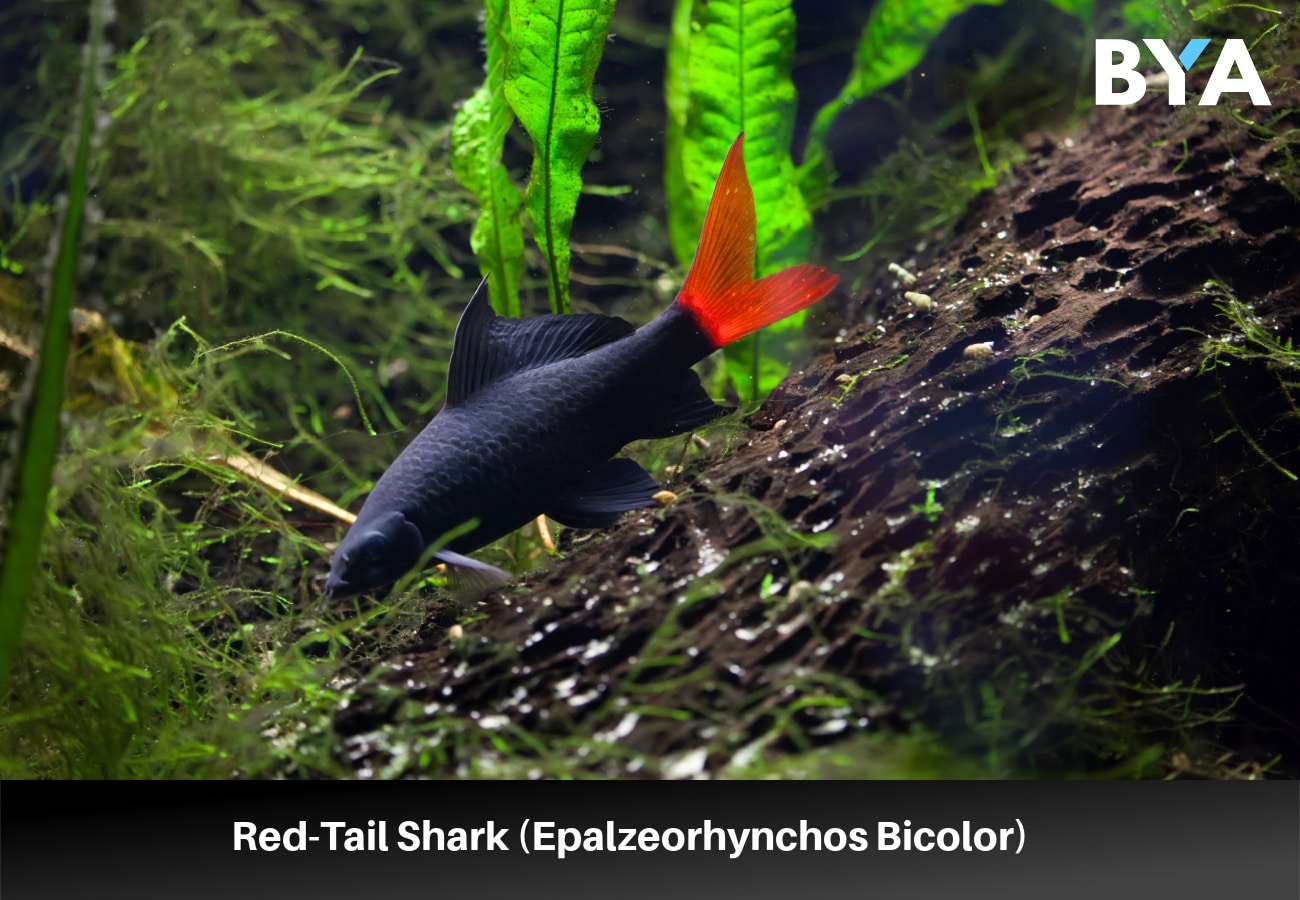
- Compatibility Rank: 9/10
- Care Level: Easy
- Size: Up to 6 in (15.2 cm)
- Aquarium Size: 55+ gallons
- Temperature Requirements: 72-79°F (22.2-26.1°C)
- pH Requirements: 6.8-7.5
- Swimming Level: Bottom
- Temperament: Semi-Aggressive
Red-tail sharks are famous for their pitch-black bodies and bright red tail fins.
Like bala sharks, they are not really sharks. They get the name for their long, streamlined, shark-like bodies.
Unlike bala sharks, red-tail sharks are not peaceful or schooling fish.
Red-tail sharks can become quite territorial and aggressive. They should not live with other members of their species.
Fortunately, they mostly stay at the bottom of the tank and hide in caves during the day. They are unlikely to bother Oscars.
Oscars are large enough to defend themselves against nippiness.
Red-tail sharks are hardy fish. They are good at handling water fluctuations and the waste that Oscars produce. They are also hearty, non-picky eaters, making them easy to care for.
17. Severums (Heros efasciatus)
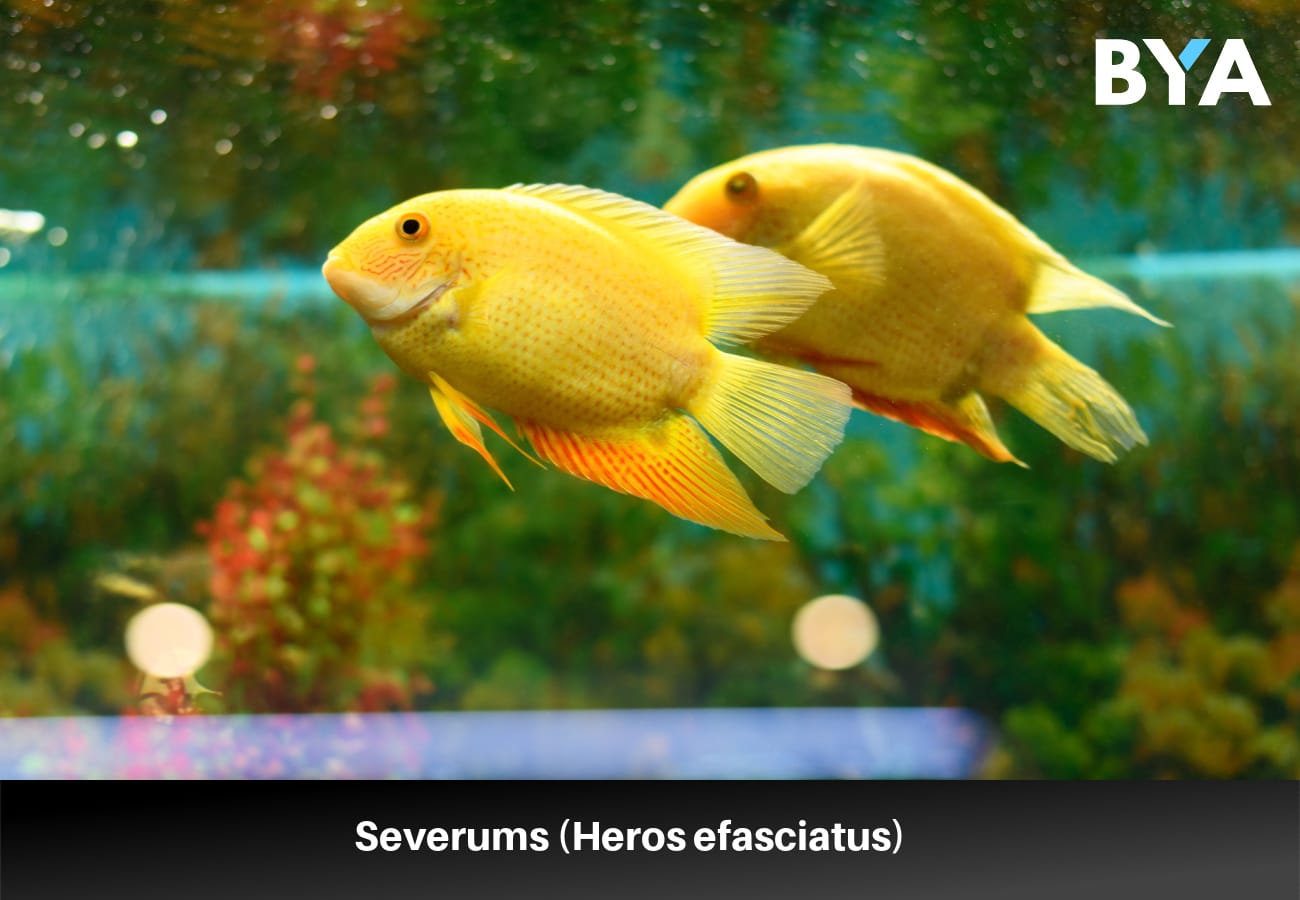
- Compatibility Rank: 10/10
- Care Level: Easy
- Size: Up to 8 in (20.3 cm)
- Aquarium Size: 40+ gallons
- Temperature Requirements: 75-80°F (23.9-26.7°C)
- pH Requirements: 6.0-7.0
- Swimming Level: Top
- Temperament: Peaceful to Semi-Aggressive
Severums are one of the most peaceful fish on this list, making it an ideal tank mate for Oscars. They prefer to stick to themselves, though they can hold their own against an Oscar if necessary.
These fish are popular for the swirling patterns and colors that cover their bodies. Some severums are bright yellow with orange patterns. Others are darker with stripes.
Severums are unique because they eat some plant matter — most cichlids don’t. They even consume fruit during the flooding season when it’s available.
18. Silver Arowana (Osteoglossum bicirrhosum)
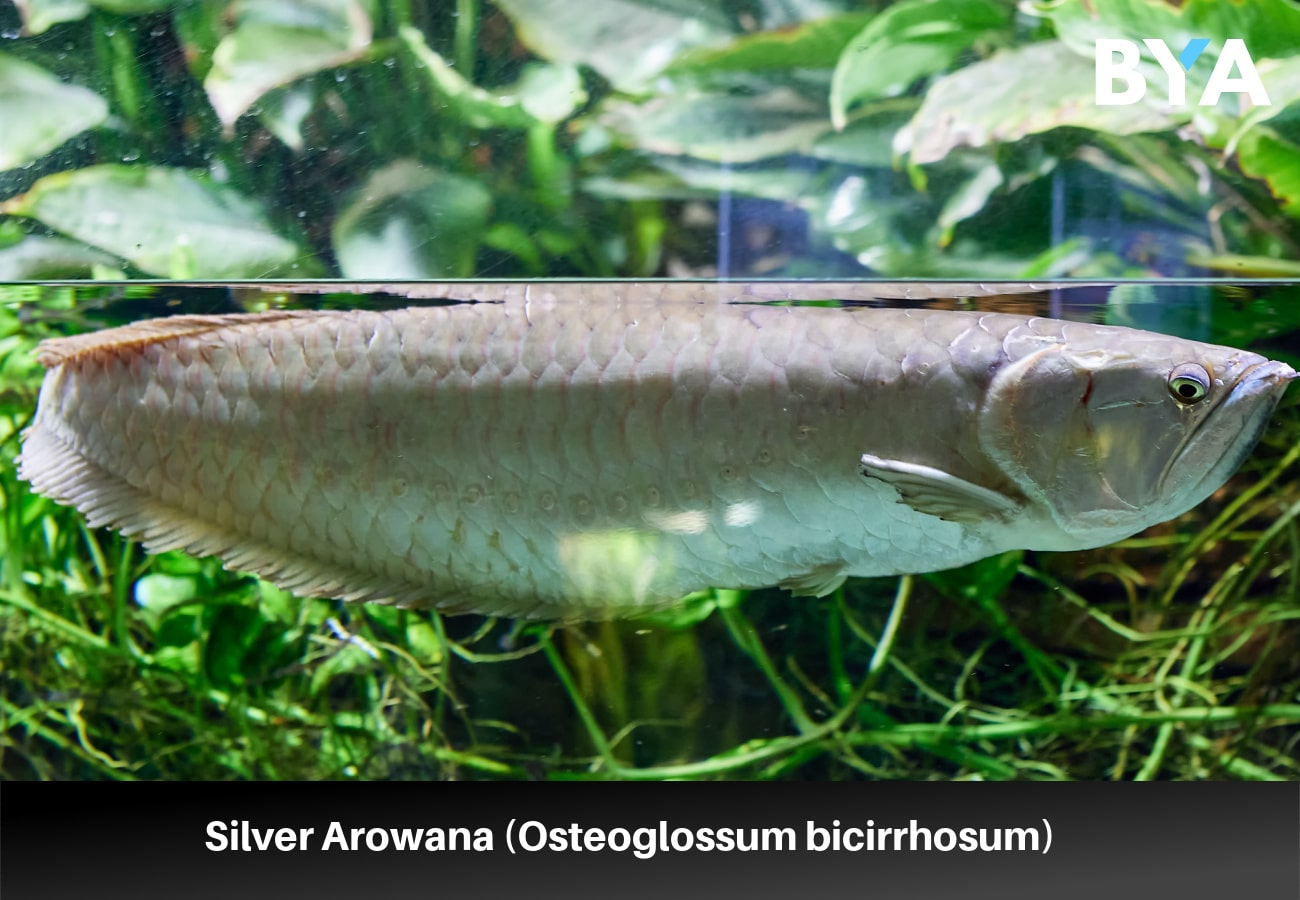
- Compatibility Rank: 7/10
- Care Level: Very Difficult
- Size: Up to 3 ft (0.9 m)
- Aquarium Size: 250+ gallons
- Temperature Requirements: 75-82°F (23.9-27.8°C)
- pH Requirements: 5.0-7.5
- Swimming Level: Top
- Temperament: Highly Aggressive
Silver Arowanas are one of the most popular species amongst long-time hobbyists. They are popular for their long, slender bodies covered in shimmering silver skin.
They are exceptionally hard to care for because of their size and aggressive natures. They won’t hesitate to eat anything that fits inside their mouths.
Aggression isn’t the only thing that makes Arowanas difficult. Arowanas need near-perfect environments and high-quality food. Oscars are dirty. Creating a clean enough environment for Arowanas is difficult.
For many, the challenge is worth it. The bright colors of Oscars nicely complement the silvery sheen of the Arowana.
Keeping Arowanas & Oscars Together
Aquarists can be successful in keeping Oscars and silver Arowanas together.
Introduce the two animals at the same time. Don’t add either species to a tank where the other has already established territory.
Further, introduce the two species as juveniles of similar sizes. The fish being similar in size is imperative to preventing injuries or fatalities.
Both fish will grow at about the same rate, ensuring neither can seriously harm the other. Growing up together also lessons aggression in the long run.
19. Silver Dollars (Characidae Family)
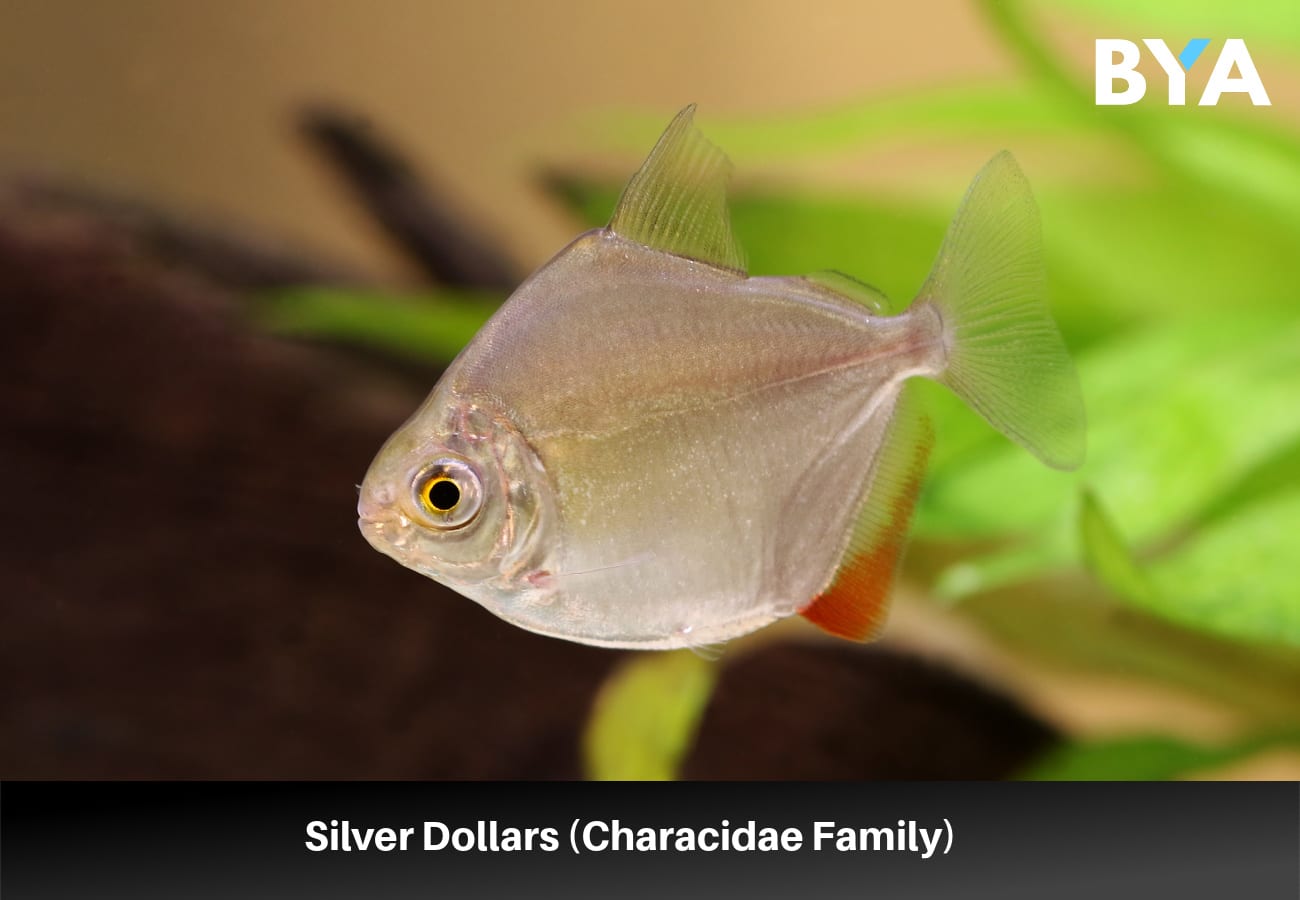
- Compatibility Rank: 10/10
- Care Level: Easy
- Size: 6-12 in (15.2-30.5 cm)
- Aquarium Size: 55+ gallons
- Temperature Requirements: 75-82°F (23.9-27.8°C)
- pH Requirements: 5.0-7.0
- Swimming Level: Middle to Top
- Temperament: Peaceful
Silver dollars are popular for their body color and shape. Their bodies are flat and round with short fins, and their scales are shimmering, silvery. They look very much like a real silver dollar.
These fish work well with Oscars because of their large, flat bodies. Since they are large, they aren’t a good snack for Oscars.
Silver dollars help put Oscars at ease and make them less aggressive.
They are schooling dither fish; they spend much time flitting around the open water of the tank. The Oscars understand that the water is safe when they see this behavior.
Oscars tend to become more active when silver dollars are around.
Here’s What Makes A Good Oscar Tank Mates
Aquarists must consider personality, size, and water and food needs. The traits of potential tank mates must be compatible with Oscars’ for them to work together.
The Fish’s Temperament
Oscars are semi-aggressive fish — as long as fish are too big to fit in the Oscars’ mouths, it’s usually fine.
Try to choose fish with similar temperaments to the Oscars.
Necessary Water Parameters
Fish must share their water parameter needs with Oscars.
Oscars need the following water parameters:
- Ammonia: 0 ppm
- Nitrites: 0 ppm
- Nitrates: <40 ppm
- pH: 6.0-7.6
- Temperature: 75-80°F (23.9-26.7°C)
The Fish’s Size
Oscars can grow to about 15 in (38.1 cm) — any tank mates need to be around the same size.
Likewise, a single or mated pair of Oscars needs no less than 65 gallons. Add another 10 to 20 gallons for each extra Oscar.
Food
Oscars are omnivores, though they mainly eat meat. Their diet primarily comprises smaller fish, shrimp, insects, and frogs.
Oscars are feisty and can usually hold their own against competitors. It is still vital to ensure tank mates cannot outcompete the Oscars for food.
Here’s What Bad Tank Mates Look Like
Don’t choose larger fish with aggressive personalities. They are likely to bully and injure Oscar(s).
Some fish to avoid are flowerhorn cichlids and red devils.
Fish smaller than the Oscars won’t work well as they’ll become a snack. Specifically, avoid small catfish. Their barbs can kill Oscars if they swallow the catfish.
Peaceful or sensitive fish are also a bad idea.
For example, Discus will face bullying from Oscars. They also need pristine water conditions, which they won’t have in the same tank as an Oscar. Oscars are messy eaters and cause the tank to get dirty quite quickly.
FAQs
Do Oscars Need Tank Mates?
Oscars don’t need tank mates as they are not social fish. They do well with or without other fish.
Can Oscars Live With Angelfish?
While Oscars and angelfish can live together, it’s not usually a good idea.
Oscars grow far larger than angelfish, who have long, delicate fins that are easy to injure.
They are both territorial fish. Fights between them are inevitable and won’t end well for the angelfish.
How Long Do Oscars Live?
Oscars are long-lived, hardy fish that can live for over a decade in the right conditions. Most live between 10 and 15 years, though some can live as long as 20 years.
Do Oscars Like Sand Or Gravel?
Both sand and gravel work well for Oscars.
Oscars are big diggers; sand is more gentle on their mouths. Sand can also cause problems with the filter as the fish fling the same into the intake.
Gravel is less gentle on their skin, though it is less likely to cause issues with filtration.

I have two 55 gallon tanks, a 20 and a 10. I have two angels, 2 3 in Oscars and a plecostomus at about 8 in Long. I would like to get discus and electric blue hap. Any advice on how to pair these fish? I have tetras in the 10 gallon tank. Thanks for any good advice. Dona
I just set up a 125 after having oscars in a 90 gallon with one g.t., 1 j.d., 2 firemouths, and 3 parrot fish. They seriouslt are water dogs and know when im around. I listened to advice from lfs and got all my fish small and same size as oscars and let em grow up together. I am so happy with these type of fush is why i wanted to get a bigger tank so i could keep them when they get bigger instead of taking back to lfs. I have had saltwater fish but these are my favorite fish ive ever kept. If you get the chance give them a try. Very fun to watch.
I keep 4 Oscar’s and 3 convicts and 1 large pleco in a 650 gal pool in my basement. I have a breeding pair of convicts but I am hesitant to put them in.what do you think?
its too risk convict chiclid baby can eat Oscar .
I have a tank of about 150 gallons, is it okay of an oscar fish? Would it be okay for a goldfish that is added (i don’t plan to keep a goldfish but from past experience with my prior oscar I must always be prepared for the unusual)? My prior oscar kept one of his feeder fish alive. She grew fast to match his size and even refused to eat goldfish flakes or pellets (it was oscar food or no food at all for her). One of them was so happy it started spraying eggs all over my tank randomly but they were healthy and happy.